On the Utility of Horizontal-to-Vertical Spectral Ratios of Ambient Noise in Joint Inversion with Rayleigh Wave Dispersion Curves for the Large-N Maupasacq Experiment
Abstract
:1. Introduction
2. Maupasacq Experiment
2.1. Study Area
2.2. Acquisition
2.3. Purpose of Horizontal-to-Vertical Spectral Ratio
3. Data Processing and Inversion Methodologies
3.1. Data Preparation and Processing
3.2. Inversion of DCs and Joint Inversion with HVSR
3.3. 3D Model Composition
4. Results
4.1. Horizontal-to-Vertical and Dispersion Curves
4.2. Benefit of 1D Joint Inversion of HVSR and DC
4.3. 1D Joint Inversion
4.4. 3D Model and Comparison with Local-Earthquake Tomography
4.5. Density Model
5. Conclusions
Author Contributions
Funding
Institutional Review Board Statement
Informed Consent Statement
Data Availability Statement
Conflicts of Interest
Abbreviations
| HVSR | Horizontal-to-Vertical Spectral Ratio; |
| 3C | Three component; |
| large-N | Large number (of measurement sites); |
| Maupasacq | Mauléon passive seismic acquisition; |
| LET | Local earthquake tomography; |
| ANT | Ambient noise tomography; |
| DC | Dispersion curve; |
| Shear wave velocity; | |
| NPFT | North Pyrenean Frontal Thrust; |
| IMT | Igountze–Mendibelza Thrust; |
| a.s.l. | Above sea level; |
| Pressure wave velocity. |
References
- Nakamura, Y. A method for dynamic characteristics estimation of subsurface using microtremor on the ground surface. Railw. Tech. Res. Inst. Q. Rep. 1989, 30, 25–33. [Google Scholar]
- Nakamura, Y. Clear Identification of Fundamental Idea of Nakamura’s technique and its applications. In Proceedings of the 12th World Conference on Earthquake Engineering, Auckland, New Zealand, 30 January–4 February 2000; p. 2656. [Google Scholar]
- Lachet, C.; Bard, P.Y. Numerical and Theoretical Investigations on the Possibilities and Limitations of Nakamura’s Technique. J. Phys. Earth 1994, 42, 377–397. [Google Scholar] [CrossRef]
- Lunedei, E.; Malischewsky, P. A Review and Some New Issues on the Theory of the H/V Technique for Ambient Vibrations. In Perspectives on European Earthquake Engineering and Seismology; Ansal, A., Ed.; Springer: Cham, Switzerland, 2015; Chapter 15; pp. 371–394. [Google Scholar] [CrossRef] [Green Version]
- Luzón, F.; Al Yuncha, Z.; Sánchez-Sesma, F.J.; Ortiz-Alemán, C. A Numerical Experiment on the Horizontal to Vertical Spectral Ratio in Flat Sedimentary Basins. Pure Appl. Geophys. 2001, 158, 2451–2461. [Google Scholar] [CrossRef]
- Ullah, I.; Prado, R.L. Soft sediment thickness and shear-wave velocity estimation from the H/V technique up to the bedrock at meteorite impact crater site, Sao Paulo city, Brazil. Soil Dyn. Earthq. Eng. 2017, 94, 215–222. [Google Scholar] [CrossRef]
- Overduin, P.P.; Haberland, C.; Ryberg, T.; Kneier, F.; Jacobi, T.; Grigoriev, M.N.; Ohrnberger, M. Submarine permafrost depth from ambient seismic noise. Geophys. Res. Lett. 2015, 42, 7581–7588. [Google Scholar] [CrossRef] [Green Version]
- Weber, S.; Fäh, D.; Beutel, J.; Faillettaz, J.; Gruber, S.; Vieli, A. Ambient seismic vibrations in steep bedrock permafrost used to infer variations of ice-fill in fractures. Earth Planet. Sci. Lett. 2018, 501, 119–127. [Google Scholar] [CrossRef]
- Kohler, A.; Weidle, C. Potentials and pitfalls of permafrost active layer monitoring using the HVSR method: A case study in Svalbard. Earth Surf. Dyn. 2019, 7, 1–16. [Google Scholar] [CrossRef] [Green Version]
- Bard, P. Microtremor measurement: A tool for site effect estimation? In Proceedings of the Second International Symposium on the Effects of Surface Geology on Seismic Motion, Yokohama, Japan, 1–3 December 1998; pp. 1251–1279. [Google Scholar]
- Fäh, D.; Kind, F.; Giardini, D. Inversion of local S-wave velocity structures from average H/V ratios, and their use for the estimation of site-effects. J. Seismol. 2003, 7, 449–467. [Google Scholar] [CrossRef]
- Almendros, J.; Luzón, F.; Posadas, A. Microtremor analyses at Teide Volcano (Canary Islands, Spains): Assessment of natural frequencies of vibration using time-dependent horizontal-to-vertical spectral ratios. Pure Appl. Geophys. 2004, 161, 1579–1596. [Google Scholar] [CrossRef]
- Lontsi, A.M.; Sánchez-Sesma, F.J.; Molina-Villegas, J.C.; Ohrnberger, M.; Krüger, F. Full microtremor H/V(z,f) inversion for shallow subsurface characterization. Geophys. J. Int. 2015, 202, 298–312. [Google Scholar] [CrossRef] [Green Version]
- Spica, Z.; Perton, M.; Nakata, N.; Liu, X.; Beroza, G.C. Shallow VS imaging of the Groningen area from joint inversion of multimode surface waves and H/V spectral ratios. Seismol. Res. Lett. 2018, 89, 1720–1729. [Google Scholar] [CrossRef] [Green Version]
- García-Jerez, A.; Seivane, H.; Navarro, M.; Martínez-Segura, M.; Piña-Flores, J. Joint analysis of Rayleigh-wave dispersion curves and diffuse-field HVSR for site characterization: The case of El Ejido town (SE Spain). Soil Dyn. Earthq. Eng. 2019, 121, 102–120. [Google Scholar] [CrossRef] [Green Version]
- Lontsi, A.M.; García-Jerez, A.; Molina-Villegas, J.C.; Sánchez-Sesma, F.J.; Molkenthin, C.; Ohrnberger, M.; Krüger, F.; Wang, R.; Fäh, D. A generalized theory for full microtremor horizontal-to-vertical [H/V(z, f)] spectral ratio interpretation in offshore and onshore environments. Geophys. J. Int. 2019, 218, 1276–1297. [Google Scholar] [CrossRef]
- Polychronopoulou, K.; Lois, A.; Martakis, N.; Chevrot, S.; Sylvander, M.; Diaz, J.; Villaseñor, A. Broadband, short-period or geophone nodes? Quality assessment of Passive Seismic signals acquired during the Maupasacq experiment. First Break 2018, 36, 71–76. [Google Scholar] [CrossRef]
- Scherbaum, F.; Hinzen, K.G.; Ohrnberger, M. Determination of shallow shear wave velocity profiles in the cologne, Germany area using ambient vibrations. Geophys. J. Int. 2003, 152, 597–612. [Google Scholar] [CrossRef] [Green Version]
- Lontsi, A.M.; Ohrnberger, M.; Krüger, F.; Sánchez-Sesma, F.J. Combining surface-wave phase-velocity dispersion curves and full microtremor horizontal-to-vertical spectral ratio for subsurface sedimentary site characterization. Interpretation 2016, 4, SQ41–SQ49. [Google Scholar] [CrossRef]
- Piña-Flores, J.; Perton, M.; García-Jerez, A.; Carmona, E.; Luzón, F.; Molina-Villegas, J.C.; Sánchez-Sesma, F.J. The inversion of spectral ratio H/V in a layered system using the diffuse field assumption (DFA). Geophys. J. Int. 2017, 208, 577–588. [Google Scholar] [CrossRef]
- Canérot, J. The pull apart-type Tardets-Mauléon Basin, a key to understand the formation of the Pyrenees. Bull. Soc. Geol. Fr. 2017, 188. [Google Scholar] [CrossRef]
- Masini, E.; Manatschal, G.; Tugend, J.; Mohn, G.; Flament, J.M. The tectono-sedimentary evolution of a hyper-extended rift basin: The example of the Arzacq-Mauléon rift system (Western Pyrenees, SW France). Int. J. Earth Sci. 2014, 103, 1569–1596. [Google Scholar] [CrossRef]
- Jammes, S.; Manatschal, G.; Lavier, L. Interaction between prerift salt and detachment faulting in hyperextended rift systems: The example of the Parentis and Mauléon basins (Bay of Biscay and western Pyrenees). AAPG Bull. 2010, 94, 957–975. [Google Scholar] [CrossRef]
- Al Yuncha, Z.; Luzón, F.; Posadas, A.; Martín, J.; Alguacil, G.; Almendros, J.; Sánchez, S. The use of ambient seismic noise measurements for the estimation of surface soil effects: The Motril City case (Southern Spain). Pure Appl. Geophys. 2004, 161, 1549–1559. [Google Scholar] [CrossRef]
- Vantassel, J.; Cox, B.; Wotherspoon, L.; Stolte, A. Mapping depth to bedrock, shear stiffness, and fundamental site period at Centreport, Wellington, using surface-wave methods: Implications for local seismic site amplification. Bull. Seismol. Soc. Am. 2018, 108, 1709–1721. [Google Scholar] [CrossRef]
- Villaseñor, A.; Chevrot, S.; Sylvander, M.; Polychronopoulou, K.; Martakis, N.; Collin, M.; Calassou, S.; Díaz, J.; Ruiz, M.; Stehly, L.; et al. Crustal architecture of the Mauléon Basin (Western Pyrenees) from high resolution local earthquake tomography using the large-N Maupasacq experiment. EGU Gen. Assem. Conf. Abstr. 2019, 21, 10657. [Google Scholar]
- Lehujeur, M.; Chevrot, S.; Villaseñor, A.; Masini, E.; Saspiturry, N.; Lescoutre, R.; Sylvander, M.; the Maupasacq Working Group. Three-dimensional shear velocity structure of the Mauléon and Arzacq basins (Western Pyrenees). BSGF Earth Sci. Bull. 2021. submitted. [Google Scholar]
- Brives, J.; Stehly, L.; Boué, P.; Paul, A. Regional ambient noise tomography of the Pyrenees using correlation of correlation. EGU Gen. Assem. Conf. Abstr. 2019, 21, 7914. [Google Scholar]
- Stehly, L.; Campillo, M.; Froment, B.; Weaver, R.L. Reconstructing Green’s function by correlation of the coda of the correlation (C3) of ambient seismic noise. J. Geophys. Res. Solid Earth 2008, 113, 1–10. [Google Scholar] [CrossRef] [Green Version]
- Neukirch, M.; García-Jerez, A.; Villaseñor, A.; Luzón, F. Horizontal-to-Vertical Spectral Ratio of Ambient Vibration obtained with Hilbert-Huang Transform. Sensors 2021, 21, 3292. [Google Scholar] [CrossRef]
- García-Jerez, A.; Piña-Flores, J.; Sánchez-Sesma, F.J.; Luzón, F.; Perton, M. A computer code for forward calculation and inversion of the H/V spectral ratio under the diffuse field assumption. Comput. Geosci. 2016, 97, 67–78. [Google Scholar] [CrossRef] [Green Version]
- Boué, P.; Brives, J.; Stehly, L.; Lehujeur, M.; Chevrot, S.; Sylvander, M.; Collin, M. Local ambient noise tomography using a dense array: The MAUPASACQ experiment. EGU Gen. Assem. Conf. Abstr. 2019, 21, 8644. [Google Scholar]
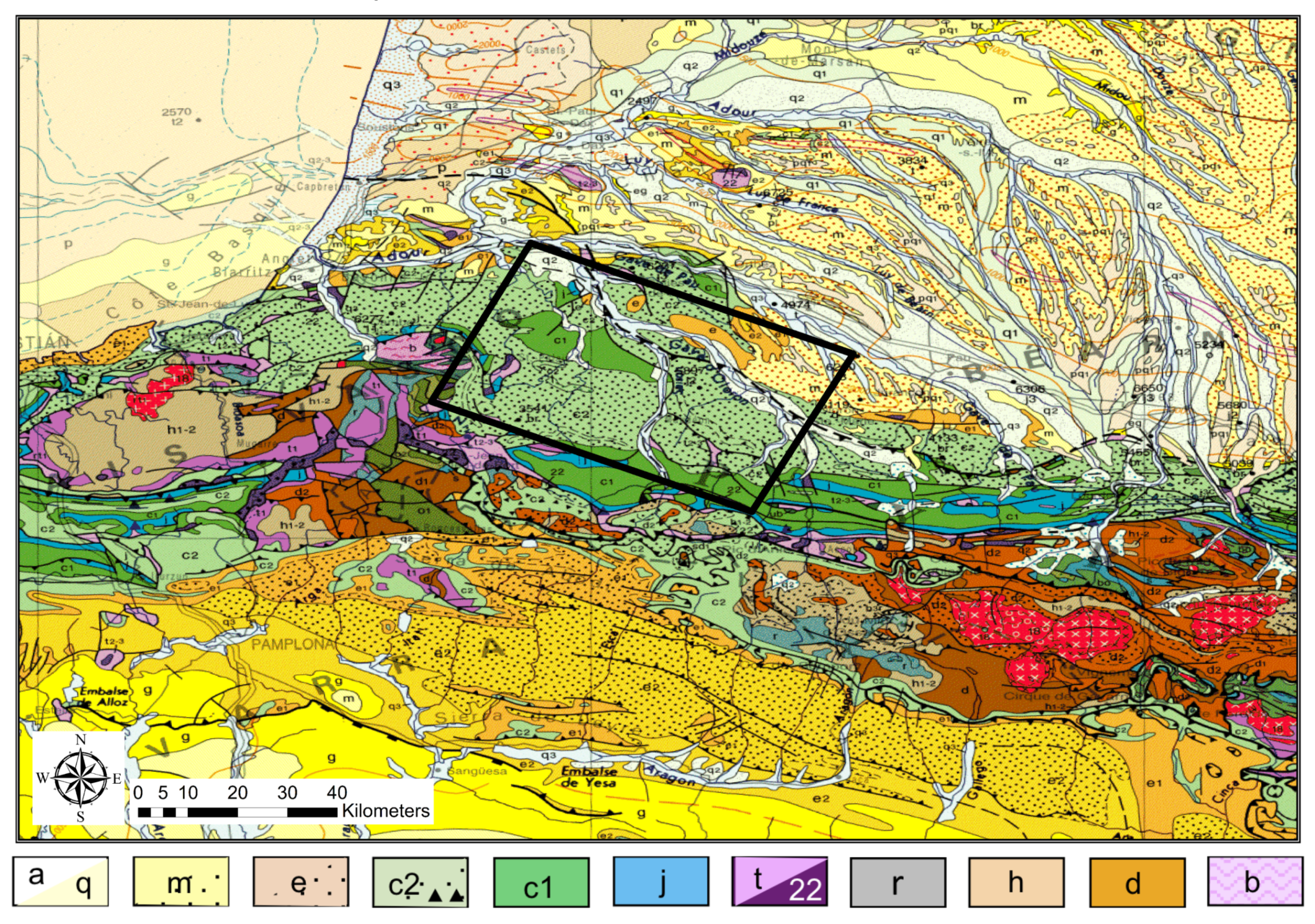
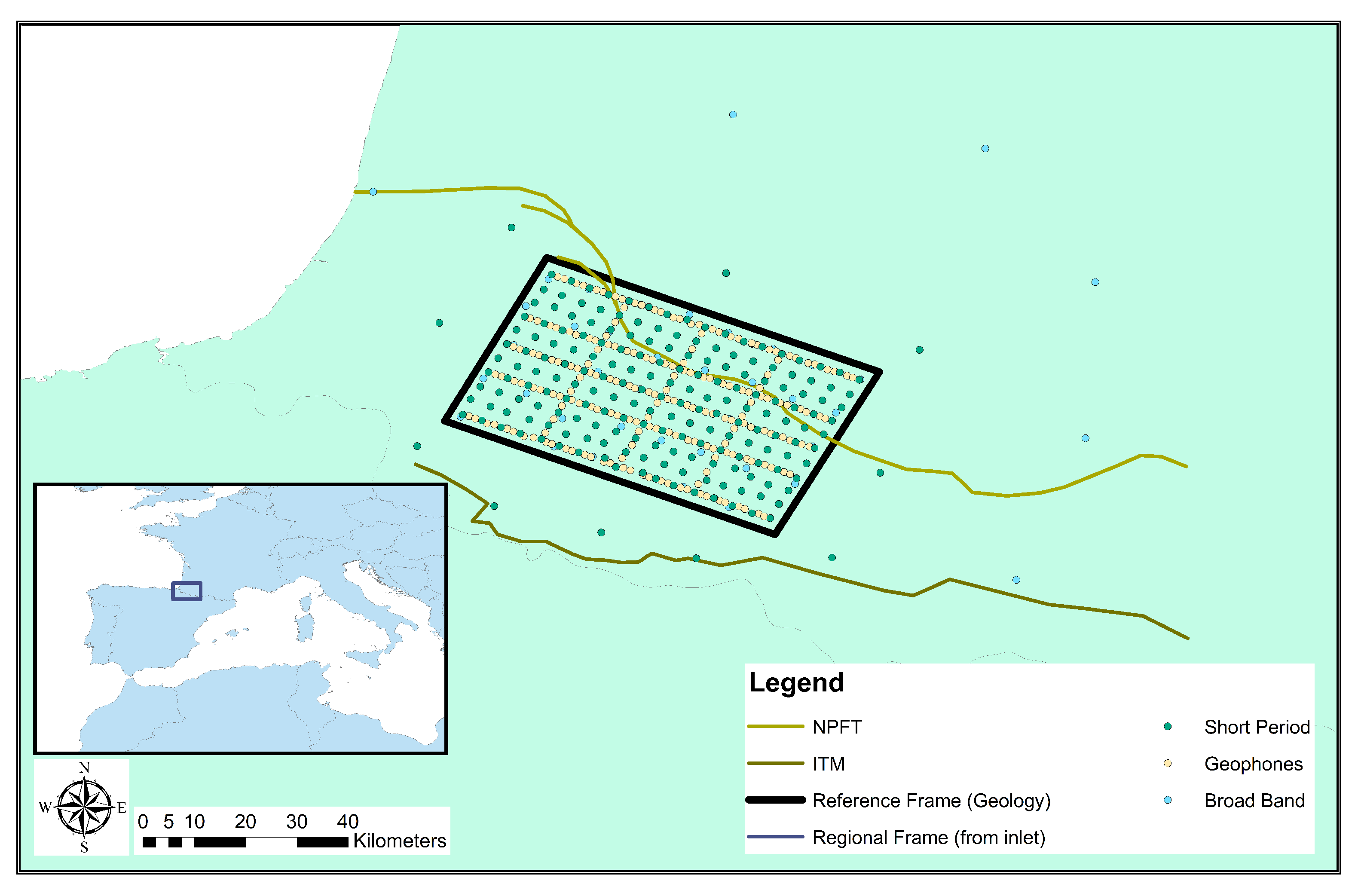
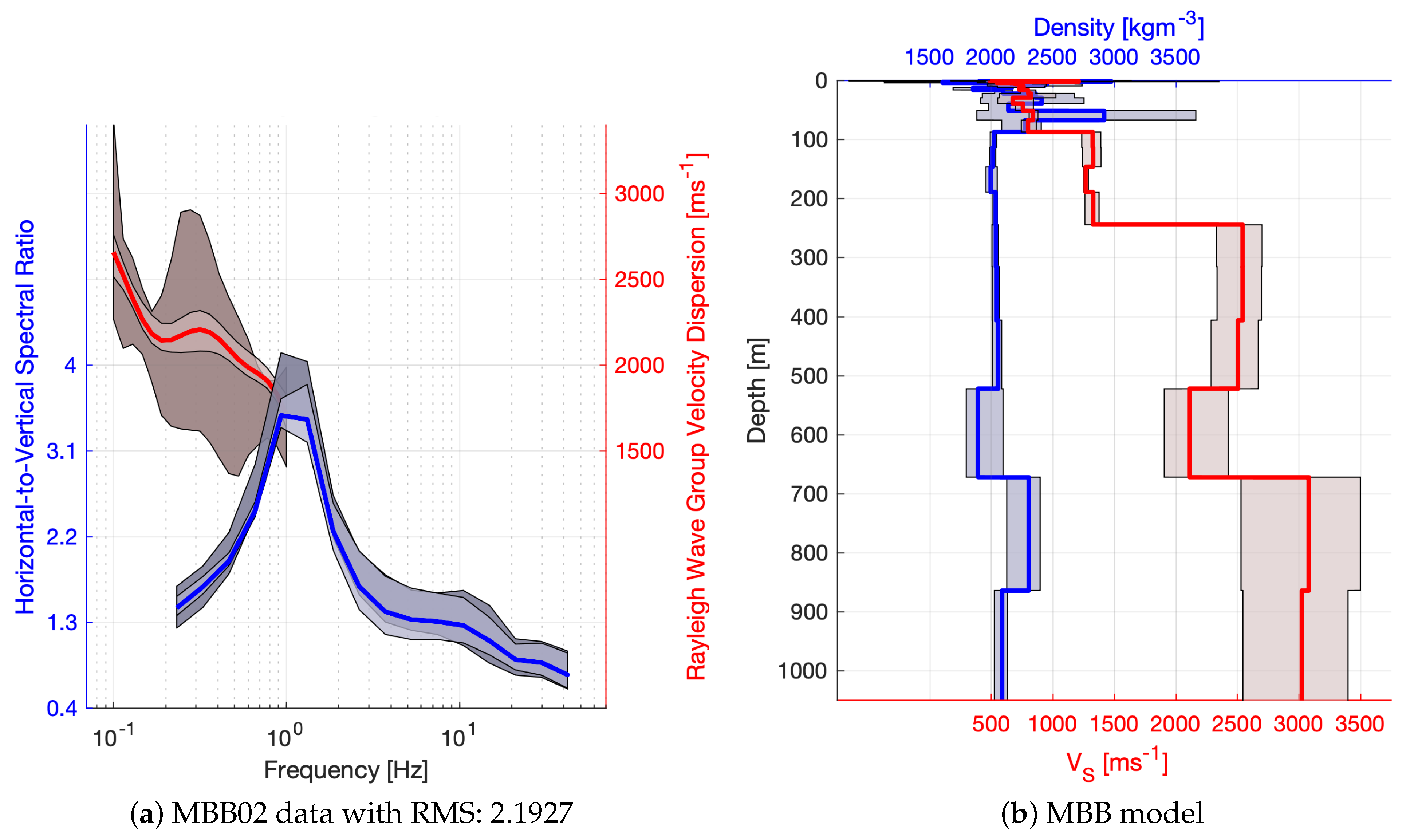

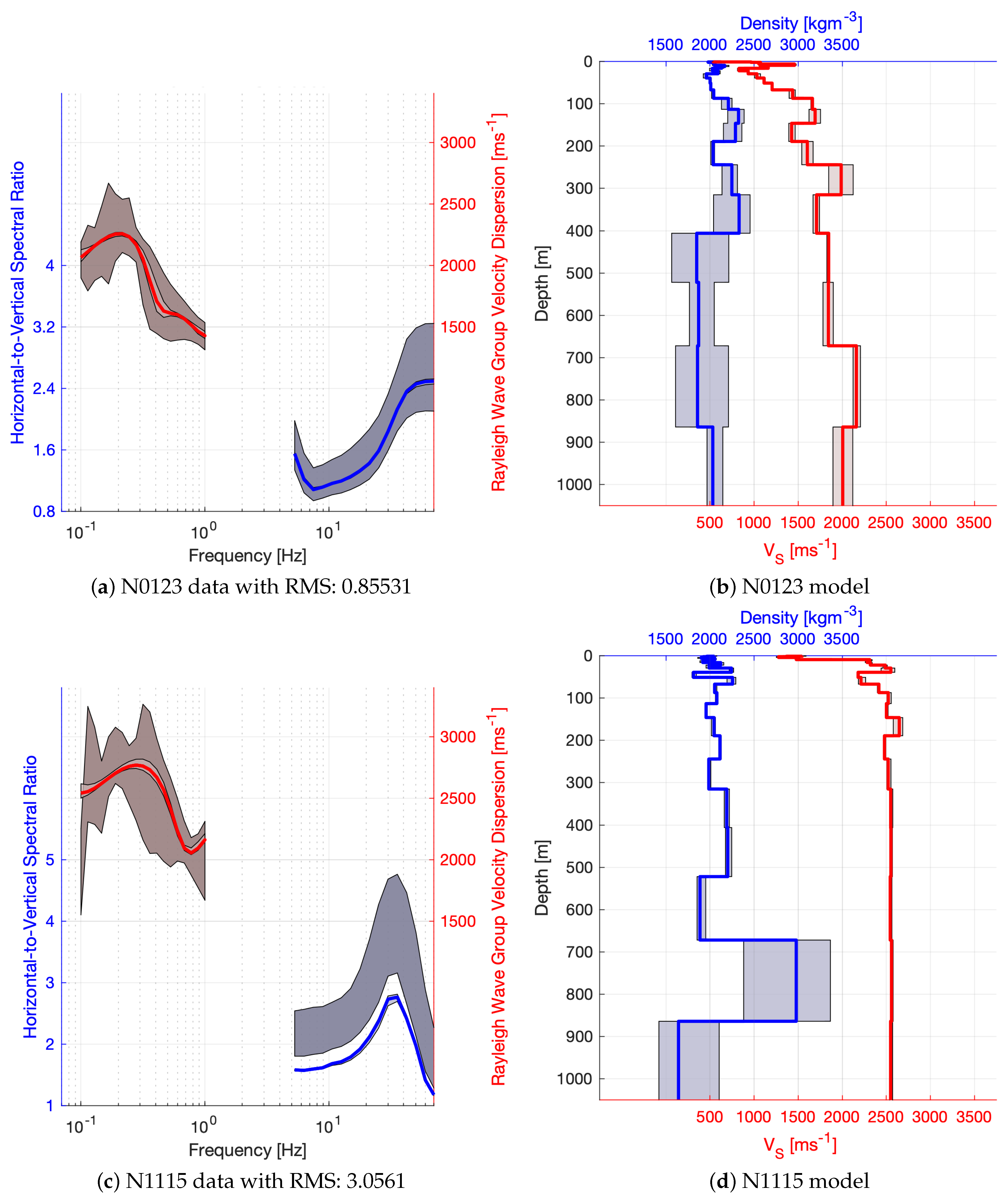
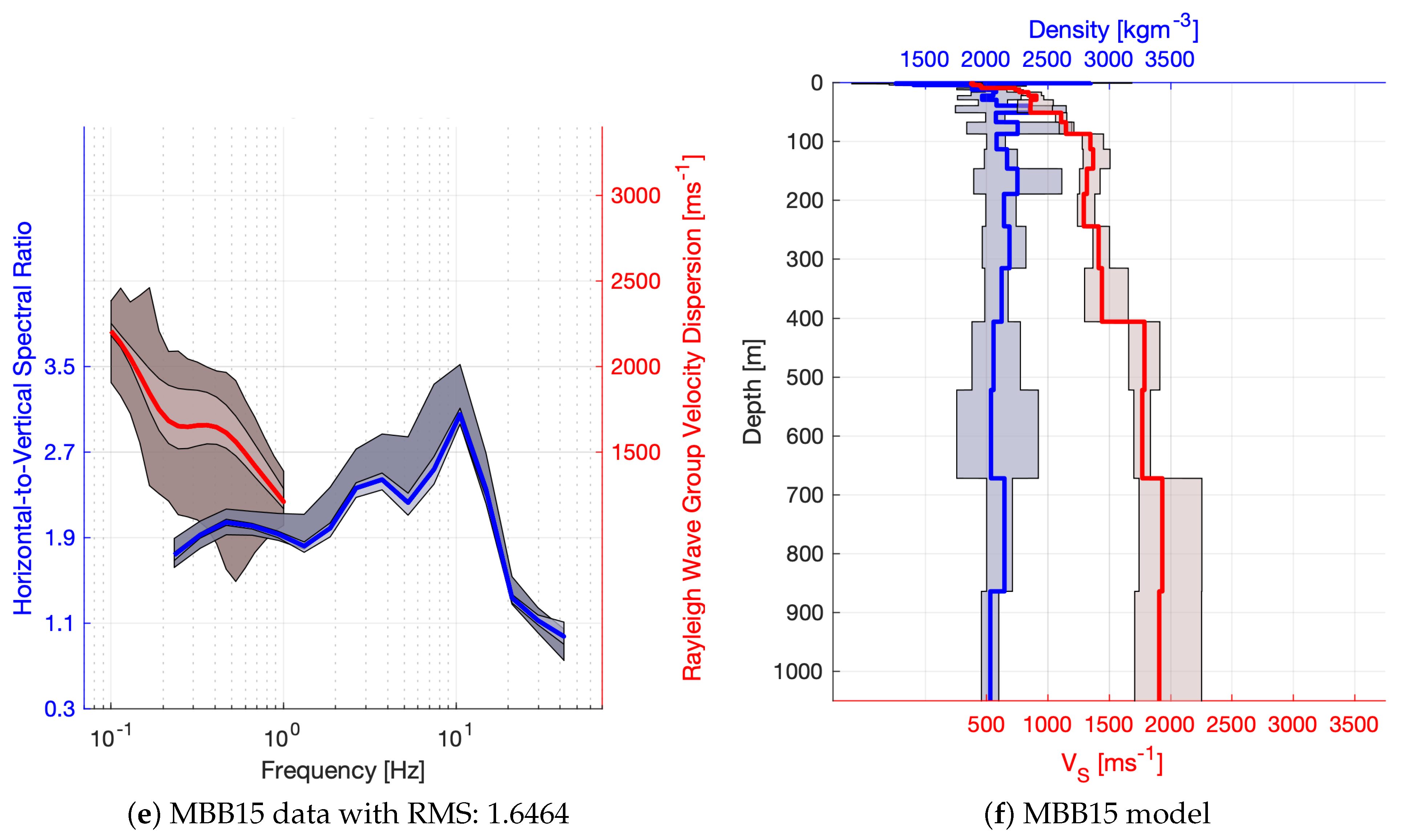
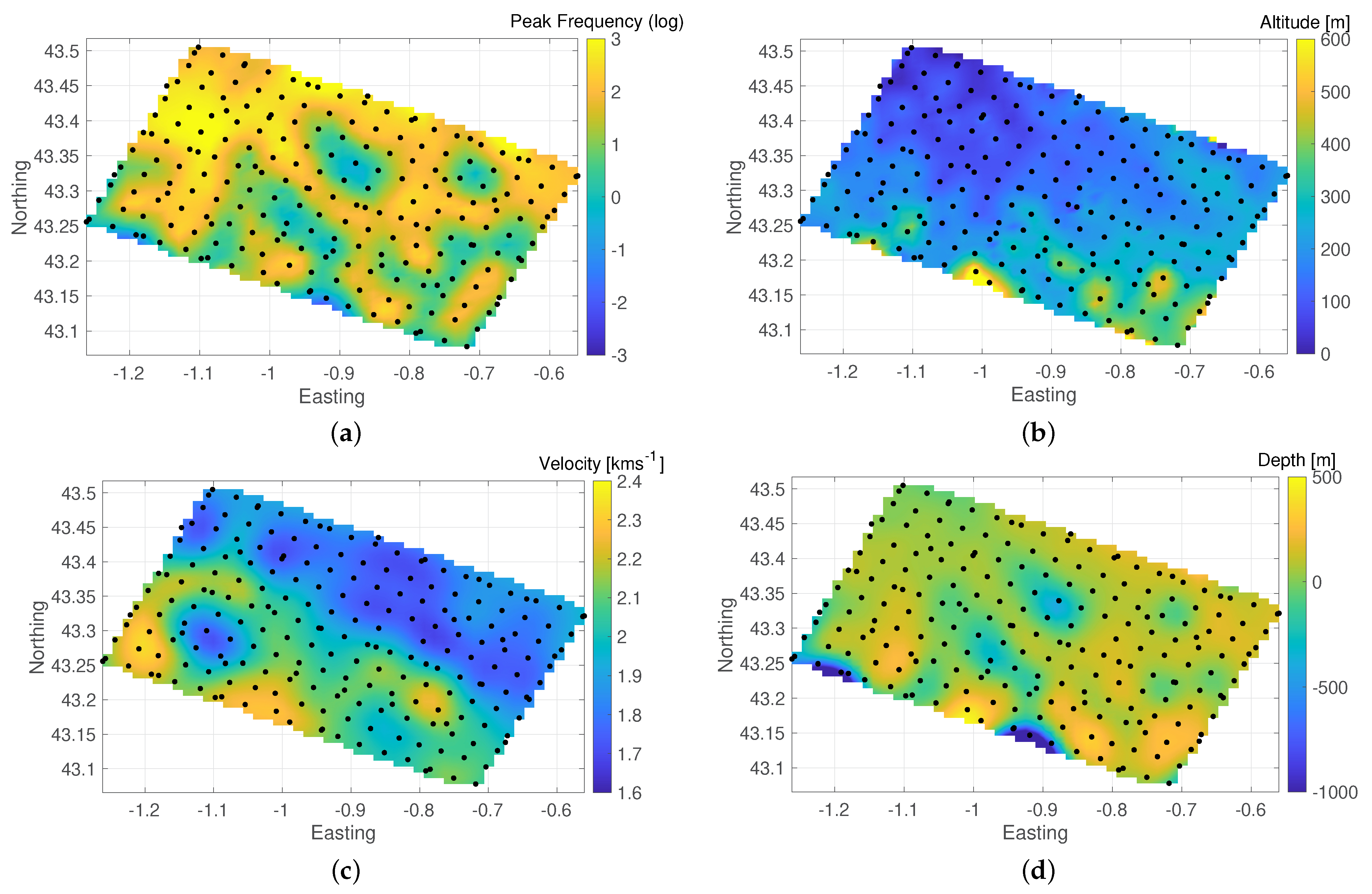

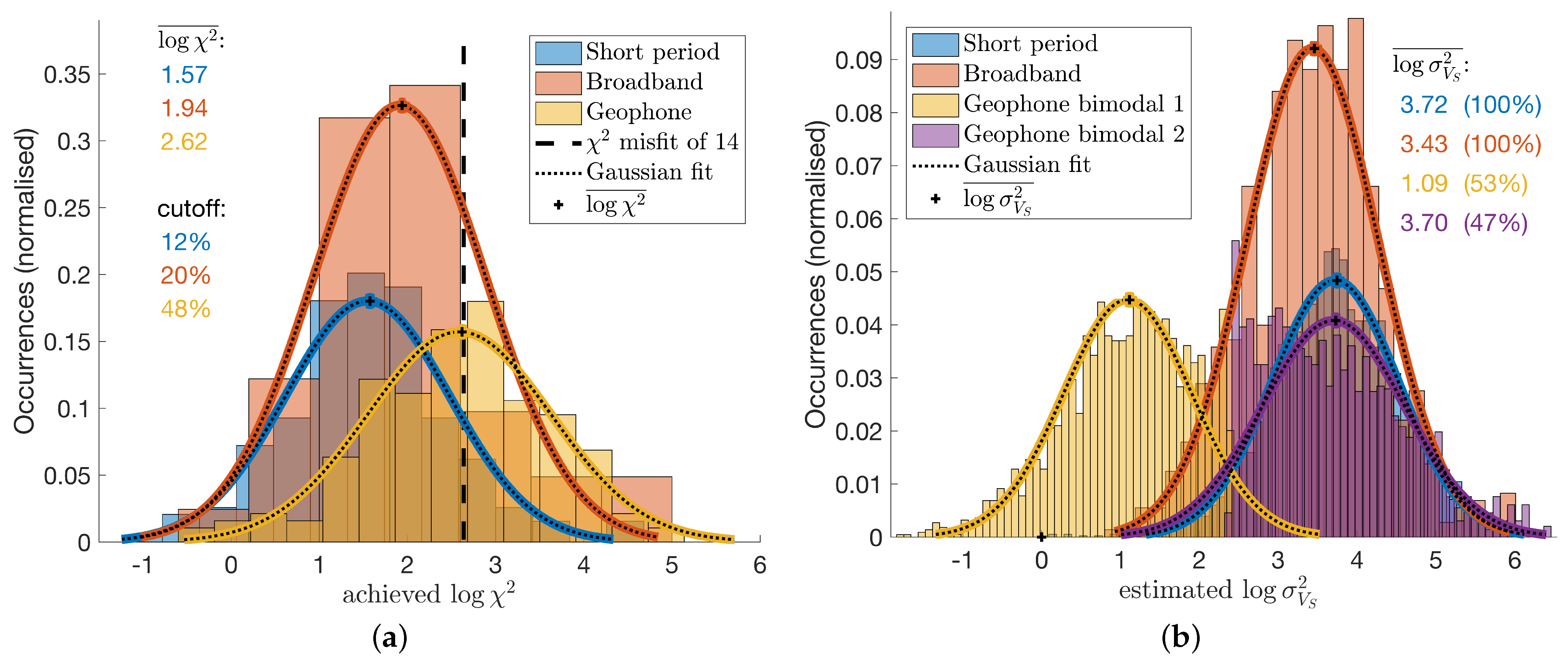
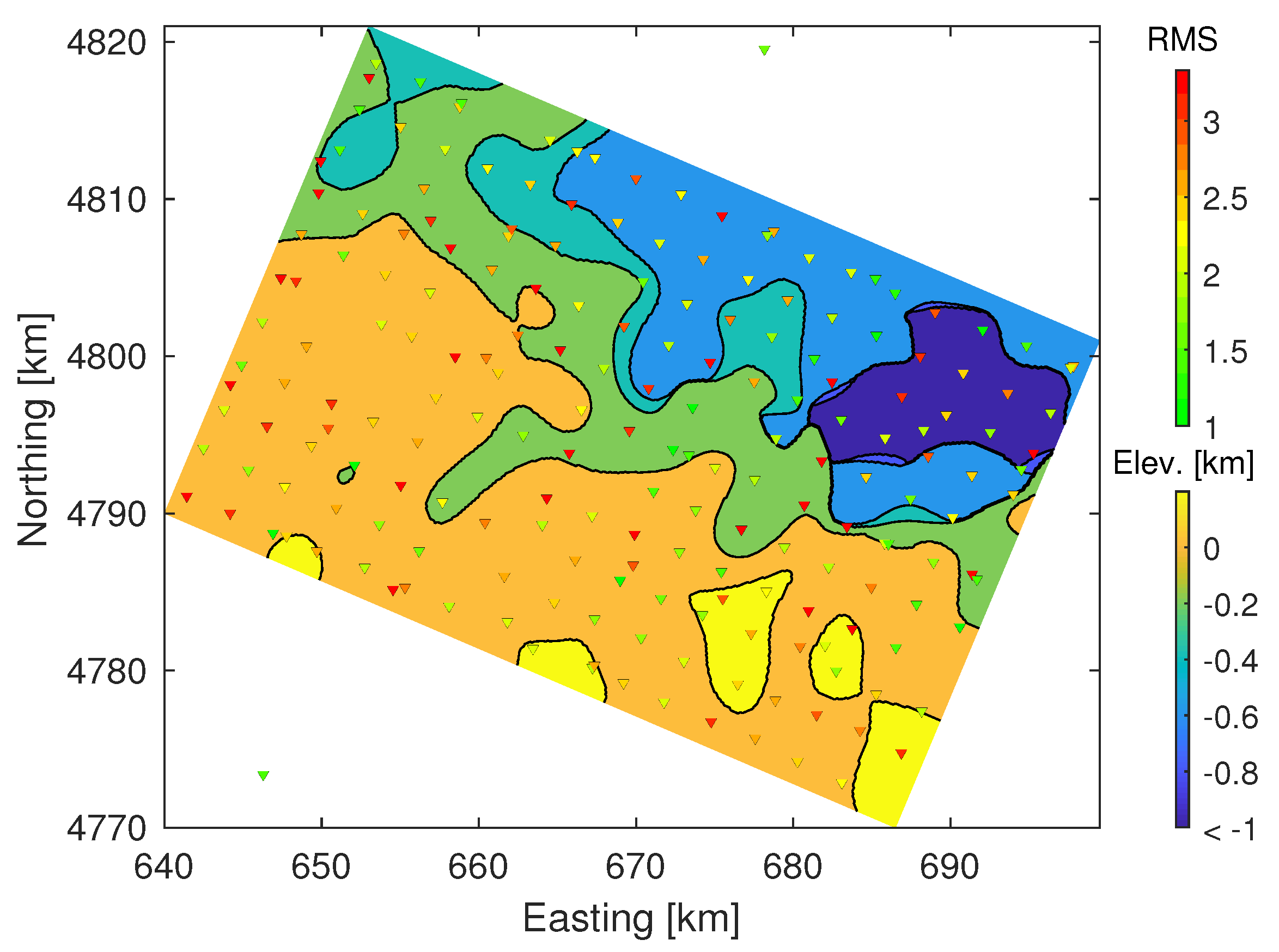

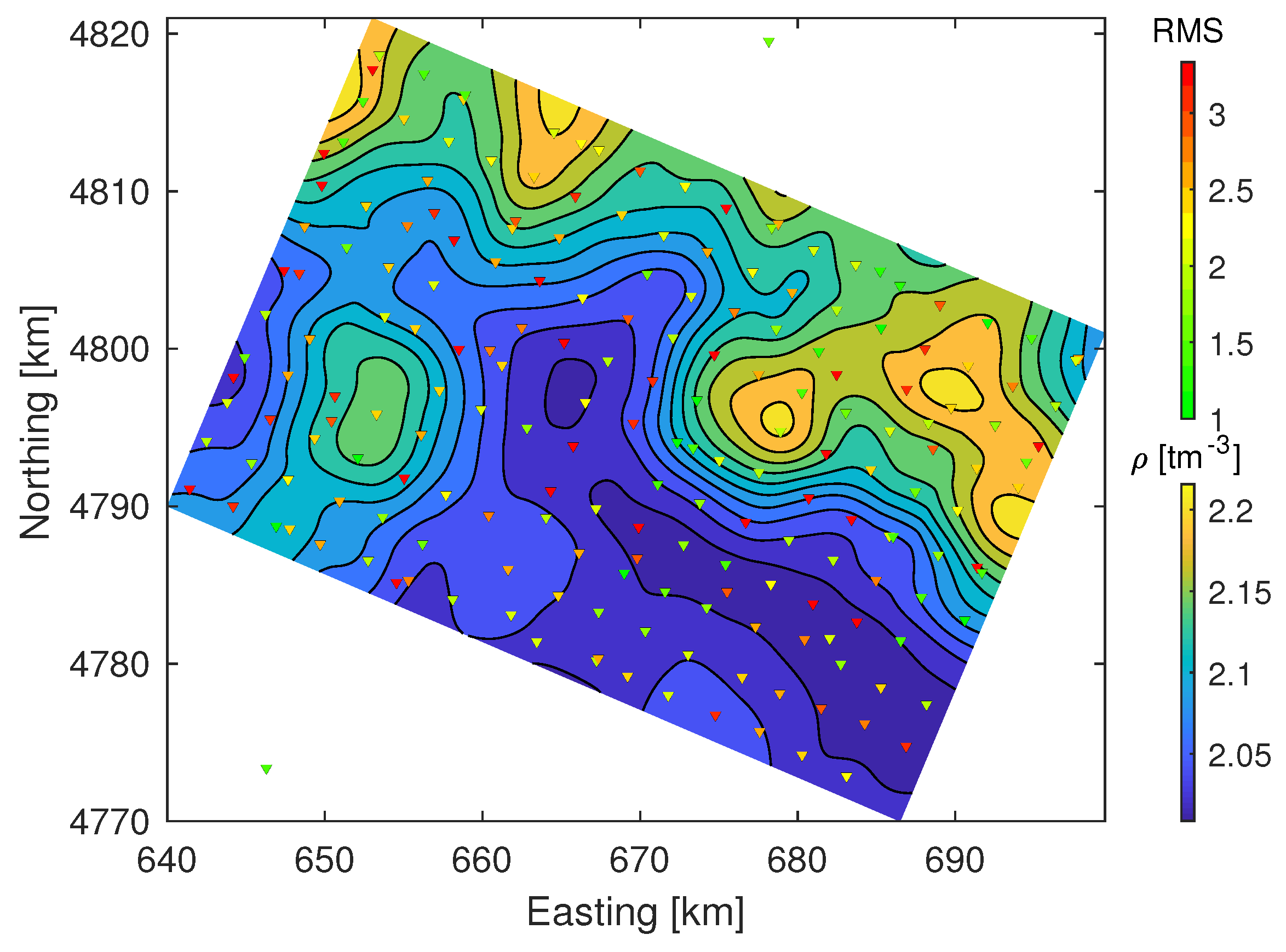
| Top Depth | Layer Thicknesses | Top Depth | ||
|---|---|---|---|---|
| Initial Model | Step 1 | Step 2 | Steps 3–5 | Final Model |
| 0 | 1 | 1 | 1 | 0 |
| 1 | 8 | 3 | 1 | 1 |
| 2 | 2 | |||
| 5 | 2 | 4 | ||
| 3 | 6 | |||
| 9 | 20 | 7 | 3 | 9 |
| 4 | 12 | |||
| 13 | 6 | 16 | ||
| 7 | 22 | |||
| 29 | 58 | 22 | 10 | 29 |
| 12 | 39 | |||
| 36 | 16 | 51 | ||
| 20 | 67 | |||
| 87 | 157 | 59 | 26 | 87 |
| 33 | 113 | |||
| 98 | 43 | 146 | ||
| 55 | 189 | |||
| 244 | 428 | 162 | 71 | 244 |
| 91 | 315 | |||
| 266 | 116 | 406 | ||
| 150 | 522 | |||
| 672 | 1163 | 439 | 192 | 672 |
| 247 | 864 | |||
| 724 | 317 | 1111 | ||
| 407 | 1428 | |||
| 1835 | 3165 | 1194 | 523 | 1835 |
| 671 | 2358 | |||
| 1971 | 863 | 3029 | ||
| 1108 | 3892 | |||
| 5000 | ∞ | ∞ | ∞ | 5000 |
| Step | # Layers | Density | ||
|---|---|---|---|---|
| 1 | 9 | to (free) | to (increasing) | (constant) |
| 2 | 16 | |||
| 3 | 30 | |||
| 4 | 30 | to (free) | ||
| 5 | 30 | 1 to (free) |
Publisher’s Note: MDPI stays neutral with regard to jurisdictional claims in published maps and institutional affiliations. |
© 2021 by the authors. Licensee MDPI, Basel, Switzerland. This article is an open access article distributed under the terms and conditions of the Creative Commons Attribution (CC BY) license (https://creativecommons.org/licenses/by/4.0/).
Share and Cite
Neukirch, M.; García-Jerez, A.; Villaseñor, A.; Luzón, F.; Brives, J.; Stehly, L. On the Utility of Horizontal-to-Vertical Spectral Ratios of Ambient Noise in Joint Inversion with Rayleigh Wave Dispersion Curves for the Large-N Maupasacq Experiment. Sensors 2021, 21, 5946. https://doi.org/10.3390/s21175946
Neukirch M, García-Jerez A, Villaseñor A, Luzón F, Brives J, Stehly L. On the Utility of Horizontal-to-Vertical Spectral Ratios of Ambient Noise in Joint Inversion with Rayleigh Wave Dispersion Curves for the Large-N Maupasacq Experiment. Sensors. 2021; 21(17):5946. https://doi.org/10.3390/s21175946
Chicago/Turabian StyleNeukirch, Maik, Antonio García-Jerez, Antonio Villaseñor, Francisco Luzón, Jacques Brives, and Laurent Stehly. 2021. "On the Utility of Horizontal-to-Vertical Spectral Ratios of Ambient Noise in Joint Inversion with Rayleigh Wave Dispersion Curves for the Large-N Maupasacq Experiment" Sensors 21, no. 17: 5946. https://doi.org/10.3390/s21175946
APA StyleNeukirch, M., García-Jerez, A., Villaseñor, A., Luzón, F., Brives, J., & Stehly, L. (2021). On the Utility of Horizontal-to-Vertical Spectral Ratios of Ambient Noise in Joint Inversion with Rayleigh Wave Dispersion Curves for the Large-N Maupasacq Experiment. Sensors, 21(17), 5946. https://doi.org/10.3390/s21175946







